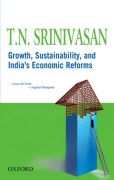
This book provides a comprehensive review of the policies and performance ofthe Indian economy from a historical and comparative perspective. It analysesthe origin, rationale, and outcomes of India's economic reforms of 1991 in the context of changes in economy, polity, and society. This book analyses the origins, rationale, and outcomes of India's economic reforms of 1991 in the context of changes in economy, polity, and society. Using a historical and comparative perspective, the book provides a comprehensive review of the policies and performance of the Indian economy.The author categorizes India's development experience into four time periods and provides a comparative analysis across these: (i) 1950-80: conservative macroeconomic policies, slow growth, and a crisis in 1966; (ii) 1980s: piecemealreforms, fiscal profligacy, accumulation of domestic and external private debt and faster growth, and the crisis of 1991; (iii) 1991-2009: systemic reformsand growth acceleration; and (iv) 2009-11: the global financial crisis. He also compares the Indianexperience with the growth and development strategies of China and certain low-income countries. Drawing lessons from economic theory to understand the policy problems faced by India, the book examines the implications of the recent global financial crisis on growth, sustainability, and the necessity forfurther reform. The intrinsic objective of India's development-the eradication of mass poverty-and the instruments for achieving it such as acceleration ofgrowth, industrialization, accumulation of physical and human capital, and improvement in productivity are highlighted. INDICE: List of Tables and Figures Preface LECTURE I: Intrinsic and Instrumental Values. Legacy of the Colonial Era: 1858-1947. Plans for National Development Prior to Independence in 1947. Establishment of the Planning Commissionin 1950. The Macroeconomic Crisis of 1966 and Economic Liberalization of 1966-68. Five Year Plans and the License Permit Raj. LECTURE II: Brief Recapitulation of the First Lecture. Political Change and Intensification of Controls of LCP. Fiscal Profligacy. Debt Accumulation and the Build-up to the Crisis of 1990-91. Domestic Shocks and Their Economic Consequences. LECTURE III: Macroeconomic and Balance of Payments Crisis of 1991. External Events and Reforms. Rationale and Content of the Reforms of 1991. Implementation of Reforms: 1991 to mid-2010. Outcome of Reforms: 1991 to mid-2010. LECTURE IV: Recapitulation of the Third Lecture. The Onset of the Global Financial Crisis. Salient Features of India's Economy: 1950-2010; Global Financial Crisis. Impact of the Crisis onIndia and China. Sustainability of Growth. Future Prospects and Conclusions. Bibliography Index
- ISBN: 978-0-19-807638-4
- Editorial: Oxford University
- Encuadernacion: Rústica
- Páginas: 120
- Fecha Publicación: 25/08/2011
- Nº Volúmenes: 1
- Idioma: Inglés
